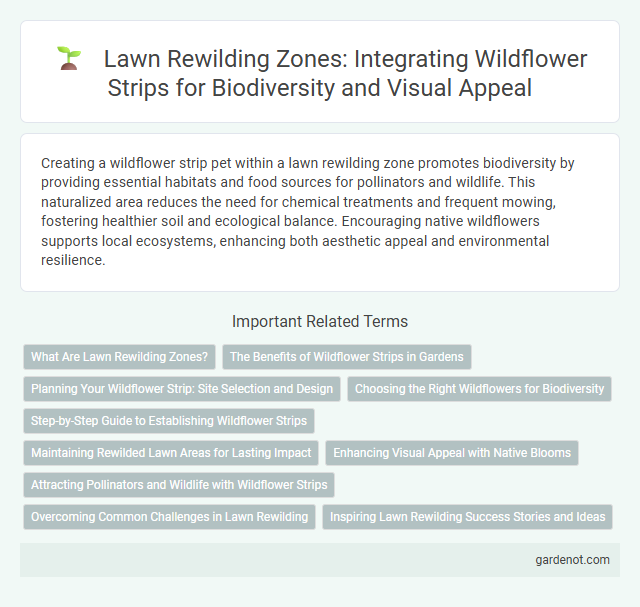Creating a wildflower strip pet within a lawn rewilding zone promotes biodiversity by providing essential habitats and food sources for pollinators and wildlife. This naturalized area reduces the need for chemical treatments and frequent mowing, fostering healthier soil and ecological balance. Encouraging native wildflowers supports local ecosystems, enhancing both aesthetic appeal and environmental resilience.
What Are Lawn Rewilding Zones?
Lawn rewilding zones are designated areas within a lawn where natural vegetation is allowed to grow freely, promoting biodiversity and supporting native wildlife. These zones reduce the need for mowing and chemical treatments, creating habitats for pollinators like bees and butterflies. By fostering native wildflowers and grasses, lawn rewilding zones contribute to ecological resilience and enhance urban green spaces.
The Benefits of Wildflower Strips in Gardens
Wildflower strips in lawn rewilding zones enhance biodiversity by providing habitat and food sources for pollinators like bees and butterflies. These strips improve soil health through natural nutrient cycling and reduce maintenance needs such as mowing and watering. Incorporating wildflower strips also supports local ecosystems, attracting beneficial insects and promoting ecological balance in garden environments.
Planning Your Wildflower Strip: Site Selection and Design
Selecting an ideal site for a wildflower strip requires assessing soil quality, sunlight exposure, and existing vegetation to ensure optimal growth conditions for native wildflower species. Designing the strip involves planned dimensions and layout that maximize biodiversity, support pollinators, and integrate seamlessly with surrounding landscape features. Incorporating native grasses and creating buffer zones enhances ecological stability and encourages beneficial insect habitats within the lawn rewilding zone.
Choosing the Right Wildflowers for Biodiversity
Selecting native wildflowers such as black-eyed Susan, coneflower, and milkweed enhances biodiversity in lawn rewilding zones by providing essential habitats for pollinators like bees and butterflies. These species adapt well to local soil and climate conditions, promoting sustainable growth and reducing maintenance needs. Incorporating a diverse mix of wildflowers supports a balanced ecosystem, improving soil health and attracting beneficial insects year-round.
Step-by-Step Guide to Establishing Wildflower Strips
Creating a wildflower strip begins by selecting a suitable lawn rewilding zone with well-drained soil and ample sunlight exposure. Prepare the ground by removing existing grass and weeds, then evenly sow a diverse mix of native wildflower seeds tailored to the region's climate and soil conditions. Regularly monitor growth, water during dry periods, and avoid mowing until flowers are fully established to ensure a thriving and biodiverse wildflower habitat.
Maintaining Rewilded Lawn Areas for Lasting Impact
Maintaining rewilded lawn areas requires regular monitoring of native plant growth and controlling invasive species to preserve biodiversity. Employing low mowing heights and seasonal cutting schedules supports wildflower regeneration and provides essential habitats for pollinators. Soil health management through organic mulching and minimal chemical use enhances ecosystem resilience in wildflower strips.
Enhancing Visual Appeal with Native Blooms
Lawn rewilding zones featuring native wildflower strips significantly enhance visual appeal by introducing vibrant, seasonally changing colors that attract pollinators and promote biodiversity. Incorporating native blooms such as black-eyed Susan, coneflowers, and wild indigo creates a natural, low-maintenance landscape that supports local ecosystems. These wildflower strips transform ordinary lawns into dynamic habitats while providing aesthetic beauty and ecological benefits year-round.
Attracting Pollinators and Wildlife with Wildflower Strips
Wildflower strips in lawn rewilding zones play a crucial role in attracting pollinators such as bees, butterflies, and hoverflies by providing a diverse range of nectar-rich flowers throughout the growing season. These strips enhance biodiversity by offering habitat and forage for various wildlife species, supporting ecosystem services like pollination and pest control. Integrating native wildflower species in rewilded lawns fosters resilient urban green spaces that sustain local wildlife populations and improve ecological balance.
Overcoming Common Challenges in Lawn Rewilding
Creating a successful wildflower strip in a lawn rewilding zone involves managing soil quality, controlling invasive species, and selecting native plants adapted to local conditions. Regularly monitoring moisture levels and avoiding excessive mowing can promote biodiversity and healthy plant growth. Addressing these challenges ensures a thriving ecosystem that supports pollinators and enhances landscape resilience.
Inspiring Lawn Rewilding Success Stories and Ideas
Wildflower strips transform traditional lawns into vibrant habitats that boost biodiversity and support pollinators. Homeowners and communities have successfully planted native wildflower species, reducing maintenance costs while creating visually stunning, ecologically rich spaces. These projects inspire widespread lawn rewilding by showcasing the ecological benefits and aesthetic appeal of sustainable, wildlife-friendly landscapes.
Lawn rewilding zone Infographic

 gardenot.com
gardenot.com